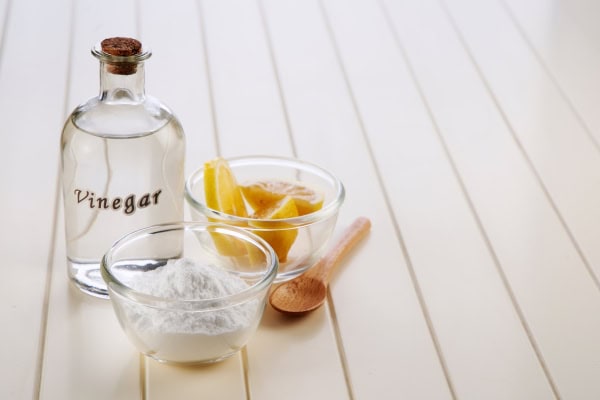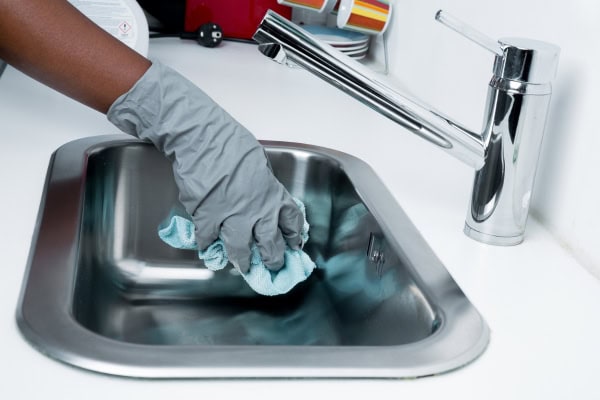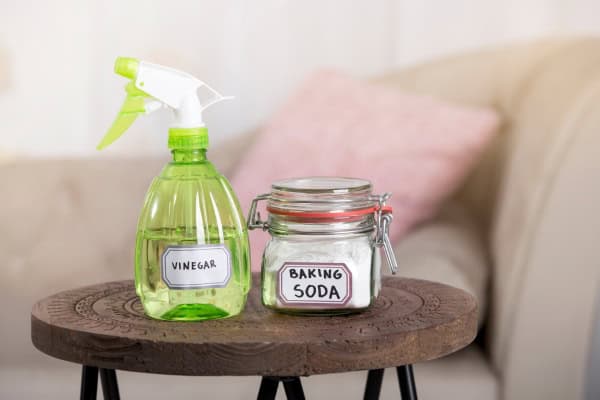Vinegar is one of those under-the-sink MVPs you reach for when store-bought cleaners just won’t cut it. Thanks to its acidity, low cost, and ability to multitask, it’s become a staple in DIY cleaning routines. Most folks swear by white vinegar for tackling grease, grime, and stubborn stains—but what if you’ve only got malt vinegar on hand?
Cue the mid-clean panic: you grab the bottle, pause, and think—can I use distilled malt vinegar for cleaning? You’re not alone. With so many types of vinegar sitting in your pantry—white, apple cider, balsamic—it’s easy to wonder which ones double as potent cleaning agents.
Here’s the good news: this post is your go-to guide to understanding how distilled malt vinegar fits into your cleaning routine. Plus, we’ll walk you through 5 surprising, practical ways to use it around the house.
Stick around—you might never look at vinegar the same way again.
Can You Use Distilled Malt Vinegar for Cleaning?

You’ve probably drizzled malt vinegar on your fries, but using it to clean your kitchen counter? That might feel like uncharted territory.
While it’s not the first vinegar that comes to mind for household cleaning, distilled malt vinegar can, in fact, do the job—though it comes with a few caveats.
Let’s start with what it does well.
Thanks to its acetic acid content, distilled malt vinegar works as a mild but effective cleaning agent. It can help remove mineral deposits in coffee makers, descale kettles, and even break down rust on small tools.
Its acidity plays a key role in dissolving buildup, making it useful in targeted cleaning chores around your home.
But here’s the catch—malt vinegar isn’t as refined as white distilled vinegar.
It carries a more intense smell and has a darker tint, especially the brown malt vinegar variety. That coloring can stain surfaces or leave behind a slight residue on lighter materials. If you’re dealing with white fabrics, glossy countertops, or glass windows, using distilled malt might do more harm than good.
The best way to use it?
Stick to areas where a strong scent or minor staining won’t be a problem. Think garage tools, garden pots, or interior parts of appliances like your coffee maker. I
t’s not ideal for laundry or as a streak-free window cleaner, but it has its niche when you need a quick, non-toxic alternative.
So, while malt vinegar might not be your go-to cleaning product, it can still earn a spot in your cleaning routine when used with care and in the right places.
5 Ways to Use Distilled Malt Vinegar for Cleaning

1. Cleaning Kitchen Countertops and Sinks
Let’s be honest—kitchen counters are like magnets for mystery spills, sticky spots, and last night’s dinner stains.
Before you reach for a harsh chemical spray, consider a more natural approach hiding in your pantry: distilled malt vinegar.
When diluted properly, distilled malt vinegar makes a surprisingly effective cleaning solution.
Simply combine equal parts vinegar and water in a spray bottle for an easy, ready-to-use cleaner for your countertops and sink. This combo helps remove grease, grime, and everyday bacteria that tend to build up in busy kitchens.
If you’re facing stubborn stains that just won’t budge, step things up a notch. Try a stronger mix—two parts vinegar to one part water—or whip up a paste with baking soda (also known as bicarbonate of soda) and vinegar.
Gently scrub the area, and watch those tough spots disappear.
Just one heads-up: skip this solution if your countertops are made of natural stone like marble or granite, as the acidity can damage the surface.
For everything else, it’s a budget-friendly, non-toxic cleaner that works wonders—and smells surprisingly sharp but clean.
2. Deodorizing and Disinfecting Drains
If your sink starts smelling funky—or your shower drain gurgles like it’s alive—it’s probably time for a refresh. And no, you don’t need to call in a plumber just yet.
A simple fizzing duo from your kitchen shelf can work magic: baking soda and distilled malt vinegar.
Start by pouring half a cup of baking soda down the drain, followed by one full cup of distilled malt vinegar. You’ll hear the satisfying fizz immediately.
That bubbling isn’t just for show—it’s a chemical reaction breaking down grease, gunk, and organic buildup deep in your pipes.
Let it sit for 10 to 15 minutes so it can work its way through minor clogs and neutralize any foul odors. Finish by flushing the drain with a pot of hot water.
This method is especially handy for kitchen and bathroom sinks, where grime and food particles love to hide.
It’s an easy, non-toxic fix that takes minutes—no gloves, no harsh chemicals, just science doing the dirty work.
3. Cleaning and De-scaling Kettles or Coffee Makers
Ever noticed a chalky buildup inside your kettle or that your morning brew doesn’t taste quite right?
That’s limescale at work, quietly collecting over time thanks to mineral deposits from water. The good news? Distilled malt vinegar can help your favorite appliances shine again—literally.
With its natural acidity, distilled malt vinegar is a potent cleaning agent for descaling kettles and coffee makers.
Just fill your kettle or coffee maker halfway with vinegar, then top it off with clean water. For kettles, bring the mixture to a boil. For coffee makers, run a regular brew cycle without any coffee grounds.
Once the cycle is complete, rinse thoroughly with warm water to eliminate any lingering smell.
You may need to run another cycle with just water to clear everything out. The vinegar breaks down mineral deposits and even helps remove rust from stainless steel components.
It’s a quick fix that keeps your appliances running efficiently—and your drinks tasting fresh.
4. Removing Limescale from Faucets and Showerheads
If your water pressure feels more like a drizzle than a shower, limescale could be the culprit.
Hard water leaves behind stubborn mineral deposits that build up around faucets and showerheads—and no, scrubbing alone won’t cut it. That’s where distilled malt vinegar steps in.
Grab a clean cloth, soak it in distilled malt vinegar, and wrap it snugly around the problem area.
Let it sit for 30 to 60 minutes—longer if the buildup has been there a while. For really stubborn spots, leaving it overnight can work wonders. After soaking, scrub gently with an old toothbrush or sponge to reveal the shine beneath the grime.
Worried about damaging delicate finishes like brushed nickel or gold-tone fixtures?
You can dilute the vinegar with warm water to make it gentler on certain surfaces. And if you still see traces of limescale after one round, don’t worry—repeating the process often gets better results.
While there are chemical products for removing calcium and rust, distilled malt vinegar gives you a low-tox, budget-friendly fix that’s surprisingly effective when used with a little patience.
5. Cleaning Pet Bowls and Litter Boxes
Let’s be honest—your pets may be adorable, but their bowls and litter boxes? Not so much. Over time, food residue, slobber, and that signature ammonia odor from cat urine can turn into a full-blown stink bomb.
Instead of covering it up with scented sprays, a more natural and effective solution might already be in your pantry.
Distilled malt vinegar is a surprisingly effective option for cleaning pet-related items.
Thanks to its acetic acid content, it acts as a potent cleaning agent, helping to neutralize the alkaline nature of pet urine while also cutting through bacteria, grime, and lingering smells. It’s especially useful for plastic or stainless steel surfaces like food bowls, litter boxes, and even pet toys.
To create a safe cleaning solution, mix one part distilled malt vinegar with two parts warm water. Use a clean cloth or sponge to wipe down the items thoroughly.
Let the mixture sit for several minutes to allow the acidity to do its job—breaking down buildup and disinfecting the surface. Afterward, rinse everything well with clean water to ensure there’s no vinegar residue left behind.
One thing to remember: while distilled malt vinegar is generally safe, it’s essential to rinse thoroughly. Your pets have a stronger sense of smell than you do, and leftover acidity could irritate them or affect their food’s taste.
This vinegar-based approach is a safer, non-toxic alternative to chemical-laden cleaners—ideal if you’re aiming for a healthier living environment for both you and your furry companions.
Whether you’re doing your weekly cleaning routine or tackling a particularly funky pet zone, distilled malt vinegar is a great tool to keep on hand. It’s budget-friendly, effective, and a smarter choice for households with pets.
Distilled Malt Vinegar Works – Just Use It Wisely

Distilled malt vinegar might not win any awards for its scent, but when it comes to tackling everyday grime, it holds its own. From kitchen messes to clogged drains and even pet bowls, this pantry staple can handle a lot—just maybe not your marble countertops or crisp white laundry.
It’s not as neutral-smelling or crystal-clear as white distilled vinegar, but if you’re working on surfaces that don’t mind a little character, it’s a solid, eco-friendly option for your cleaning routine.
But hey—if you’d rather skip the smell, the scrubbing, and the mixing of equal parts this and that, we get it.
Why DIY when you can book and chill?
Let Atlanta Maids take cleaning off your to-do list. Our expert team tackles dirt, grime, and stubborn stains—no vinegar fumes required.
Book your cleaning service in minutes or call (404)-905-5141 and say goodbye to mess, stress, and that faint smell of pickles in the air.
We clean. You relax. Simple as that.
FAQs
Can I use distilled malt vinegar instead of white vinegar for cleaning?
You can, but it depends on what you’re cleaning. Distilled malt vinegar has a stronger smell and darker color than white vinegar, which means it may stain certain surfaces or fabrics. While it still contains enough acetic acid to act as a cleaning agent, it’s better suited for tougher, less visible cleaning tasks—like removing rust or cleaning drains. For jobs like cleaning windows, white distilled vinegar is the better choice since it’s clear and leaves fewer residues. If you’re looking to avoid harsh chemicals, both options offer a non-toxic alternative.
Can I use distilled malt vinegar for cleaning the washing machine?
Yes, but only with caution. While distilled malt vinegar can help remove mineral deposits and neutralize odors, its brown tint could stain white laundry or the machine’s rubber components over time. If you’re doing a maintenance clean—no clothes involved—you can run a hot wash cycle with a cup of diluted malt vinegar to freshen the drum and reduce buildup. However, for routine cleaning purposes, distilled white vinegar or cleaning vinegar is often the better, safer option for your appliance.
Is distilled malt vinegar the same as spirit vinegar?
Not quite. Distilled malt vinegar is made from fermented malted barley and has a darker color and stronger scent. Spirit vinegar, often labeled as white vinegar or distilled white vinegar, is made from pure alcohol and has a higher acetic acid content, making it more neutral and preferred for cleaning tasks. While both can be used as household cleaning agents, spirit vinegar is less likely to leave residue or smell and is typically better for delicate surfaces and fabrics.
How to use distilled malt vinegar for cleaning mold?
To clean mold with distilled malt vinegar, dilute it with water—about equal parts—and spray it directly on the affected area using a spray bottle. Let it sit for an hour so the acetic acid can break down mold spores. Scrub the area gently and rinse with warm water. This method is useful for non-porous surfaces like tiles or plastic, but avoid using brown malt vinegar on light-colored surfaces, as it may stain. For extra mold-fighting power, you can add a few drops of tea tree oil to the mixture.

